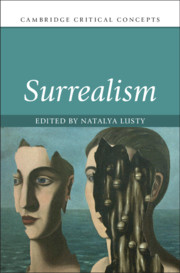Book contents
- Surrealism
- Cambridge Critical Concepts
- Surrealism
- Copyright page
- Contents
- Illustrations
- Notes on Contributors
- Acknowledgments
- Introduction: Surrealism’s Critical Legacy
- Part I Origins: Ideas/Concepts/Interventions
- Part II Developments: Practices/Cultures/Material Forms
- Chapter 7 Surrealist Collections in Paris and Sussex
- Chapter 8 Surrealist Objects
- Chapter 9 Collage
- Chapter 10 Film
- Chapter 11 Photography in Surrealism
- Chapter 12 Surrealist Fashion
- Chapter 13 Surrealist Display Practices
- Part III Applications: Heterodoxies and New Worlds
- Select Bibliography
- Index
Chapter 7 - Surrealist Collections in Paris and Sussex
from Part II - Developments: Practices/Cultures/Material Forms
Published online by Cambridge University Press: 23 July 2021
- Surrealism
- Cambridge Critical Concepts
- Surrealism
- Copyright page
- Contents
- Illustrations
- Notes on Contributors
- Acknowledgments
- Introduction: Surrealism’s Critical Legacy
- Part I Origins: Ideas/Concepts/Interventions
- Part II Developments: Practices/Cultures/Material Forms
- Chapter 7 Surrealist Collections in Paris and Sussex
- Chapter 8 Surrealist Objects
- Chapter 9 Collage
- Chapter 10 Film
- Chapter 11 Photography in Surrealism
- Chapter 12 Surrealist Fashion
- Chapter 13 Surrealist Display Practices
- Part III Applications: Heterodoxies and New Worlds
- Select Bibliography
- Index
Summary
Surrealism thrived within environments characterized by a profusion of collected objects that inspired the surrealist collector’s work and thought. André Breton (in Paris) and Roland Penrose and Lee Miller (in Sussex) had well-documented collections that reveal the practice of collecting at the root of surrealist theories of the object; they anticipated recent explorations of new materialism by Bruno Latour and Jane Bennett, and of the object as thing by W. J. T. Mitchell. Breton saw “concealed realities” and “latent possibilities” in objects in a way that foreshadowed the “vital materialism” Bennett finds in things. Like Breton, Penrose and Miller favored objects that had had a ceremonial function in their culture of origin, remote in time as well as geographically, as a way of understanding themselves better. In both collections, the impressive sculptures from the Pacific Islands exemplify the surrealist desire to orient the self within a larger world through objects capable of looking back.
- Type
- Chapter
- Information
- Surrealism , pp. 131 - 150Publisher: Cambridge University PressPrint publication year: 2021

